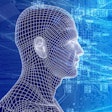
PORTLAND, OR - While most radiologists are satisfied with their radiology workstation configuration, those who aren't tend to be younger and would prefer more monitors dedicated to nonimaging tasks, according to research presented on Thursday at the Society for Imaging Informatics in Medicine (SIIM) annual meeting.
Researchers from the University of Maryland surveyed all members of the Association of University Radiologists (AUR) and found that older radiologists tended to be happy with their current setup, while younger radiologists tended to have higher perceived difficulty from their existing configuration. What's more, they also expected greater utility from having additional monitors for nonimaging purposes, such as for displaying case information/worklists, speech recognition software, the electronic medical record (EMR), phone lists, email, or a web browser. Younger radiologists also tended to have more applications open on the nondiagnostic monitors than did older radiologists.
"Younger radiologists tend to think more monitors would be helpful, whereas older ones [tend to] think that maybe additional monitors would be harmful," said Dr. Arjun Sharma, a former informatics fellow at the University of Maryland and currently a private-practice radiologist in Chicago.
Heterogeneous workspaces
There's a lot of heterogeneity in radiology workspaces today; some radiologists use one monitor for nondiagnostic purposes while others use two or more. To get a sense of how radiology workspaces are configured across the U.S., the research team sent a survey to all AUR members in February 2015.
The survey included 10 questions related to the use of diagnostic and nondiagnostic monitors. For the purpose of the study, Barco's "seamless" monitors were treated as two monitors. Also, the term "diagnostic" was used interchangeably with "imaging." "Case info" was considered nondiagnostic display.
The researchers received 336 responses; 17 (5.1%) were from individuals younger than 30, 122 (36.4%) were from those 30 to 40 years old, 65 (19.4%) were from those 40 to 50, 37 (11%) were from those 60 to 70, and 13 (3.9%) were from those older than 70. There was close to an even split in the number of nondiagnostic monitors used in a typical workspace:
- 1 monitor: 155 (46.1%)
- 2 monitors: 171 (50.9%)
- > 2 monitors: 9 (2.7%)
Most respondents (67%) said that dictation software dominated screen time on the nondiagnostic monitor. Others pointed to case information (21%) and the electronic medical record (10%).
The radiologists had varying views on the perception of their current setup:
- Current setup is neither difficult nor easy: 33%
- Current setup is relatively easy: 39%
- Current setup is relatively difficult: 28%
The researchers also found differences in the respondents' expectations of the usefulness of additional monitors for nondiagnostic use:
- Additional monitors would be neither harmful nor helpful: 33%
- Additional monitors would be helpful: 35%
- Additional monitors would be harmful: 31%
Most radiologists keep an average of three to five applications or webpages open on the nondiagnostic monitors.
Surprising findings
Delving deeper into their analysis, the researchers found that older radiologists were more likely to find their current setup easy to use, while there were bimodal opinions for the younger radiologists. What's more, the older the radiologist, the less likely he or she was to believe that additional nondiagnostic monitors would be helpful.
In addition, younger radiologists were more likely to have more applications open on the nondiagnostic monitor. Most radiologists older than 60 had three or fewer applications open; in contrast, most of those with at least six applications open were younger than 50. Those younger than 30 most commonly had six or more open applications.
The researchers also found an indirect association between the number of applications kept open and the perceived ease of use of the workstation.
"If you keep more and more things open, you're more and more likely to find your current setup difficult," Sharma said.
Users who kept fewer applications open tended to be less likely to believe that additional monitors would be helpful, according to the group.
Those with two or more nondiagnostic monitors also had higher reported levels of ease of use, compared with those who only had one monitor.



















